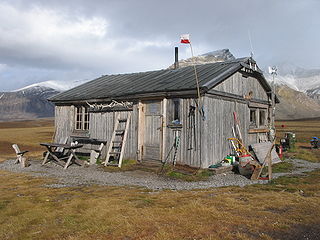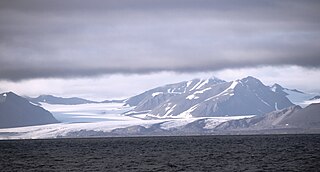Related Research Articles

Oscar II Land is the land area between Isfjorden and Kongsfjorden on Spitsbergen, Svalbard. The 30 km (19 mi) long glacier Sveabreen divides Oscar II Land from James I Land.

Trygghamna is a bay in Oscar II Land at Spitsbergen, Svalbard. It is about six kilometer long, located at the northern side of Isfjorden, east of Protektorfjellet, and separated from Ymerbukta by the mountain chain Värmlandryggen.
St. Jonsfjorden is a fjord in Oscar II Land at Spitsbergen, Svalbard. It has a length of 21 kilometer, and opens westwards into the strait of Forlandsundet. Several glaciers debouche into the fjord, including Gaffelbreen and Konowbreen from the north, a merge of Osbornebreen, Devikbreen, Vintervegen, Paulbreen and Bukkebreen at the bottom, and Vegardbreen, Charlesbreen and Bullbreen from the south.
Gipsvika is a bay in Bünsow Land at Spitsbergen, Svalbard. It is located at the mouth of Gipsdalen, at the northern side of Sassenfjorden. The bay has a width of about two nautical miles.
Ginevra Bay is the inner part of Storfjorden, Svalbard, between Barentsøya and Spitsbergen. It is named after James Lamont's vessel Ginevra.
Colesbukta is a bay at the southern side of Isfjorden, in Nordenskiöld Land at Spitsbergen, Svalbard. The bay is about 4.5 kilometers wide. A railway for coal transport was earlier operated between Grumantbyen and shipment facilities in Colesbukta. The valley Colesdalen debouches into Colesbukta.
Agardhbukta is a bay between Sabine Land and Heer Land at Spitsbergen, Svalbard. It is located at the western side of Storfjorden. It has a length of about 5.5 kilometers and is a continuation of the valley Agardhdalen. The bay is named after botanist Jacob Georg Agardh. The river Agardhelva debouches into the bay. The coastal plain Belemnittsletta is to the east of the bay. Inside of the bay is the inlet Båtbogen.
Tirpitzøya is an island in the Svalbard archipelago, one of the islands of Kong Karls Land. It has a length of about 3.3 kilometers, and is located outside the bay of Breibukta of Kongsøya. The island is named after German admiral Alfred von Tirpitz.
Breibukta is a bay at the southern side of Kongsøya in Kong Karls Land, Svalbard. It stretches from Kapp Altmann via Helgoland Island to Vestre Tømmerpynten at the headland Tømmerneset.
Kapp Altmann is a headland at the southern side of Kongsøya in Kong Karls Land, Svalbard. It has a length of 1.9 kilometers and a width between 100 and 200 meters. Outside the spit are two small islands. The headland is named after Arctic explorer Johan Andreas Altmann. Kapp Altmann defines the western extension of the bay Breibukta.
Kyrkjevika is a bay at the southwestern coast of Svenskøya in Kong Karls Land, Svalbard. Kyrkjevika is partly sheltered by Antarcticøya and other islands.
Antarcticøya is an island at the southwestern coast of Svenskøya in Kong Karls Land, Svalbard. It is located outside the bay of Kyrkjevika. The island is named after the ship Antarctic. Antarcticøya is the largest among several small islands at the outer part of Kyrkjevika.

Kükenthaløya is an island between Barentsøya and Olav V Land, Svalbard. It is located south of the strait Heleysundet and north of Ormholet, at the inner part of Ginevra Bay. The island is named after German zoologist and Arctic explorer Willy Kükenthal.
Zeppelinhamna is a cove at the northern side of the peninsula Brøggerhalvøya in Oscar II Land at Spitsbergen, Svalbard. It extends between the points Mainzodden and Gluudneset, and the island Prins Heinrichøya is located in the bay. The cove is named after German airships designer Ferdinand von Zeppelin.
Mainzodden is a headland in Oscar II Land at Spitsbergen, Svalbard. It is located in Ny-Ålesund at the southwestern side of Kongsfjorden, and marks the northern extension of the bay Zeppelinhamna.
Gluudneset is a headland in Oscar II Land at Spitsbergen, Svalbard. It is located south of Ny-Ålesund at the southwestern side of Kongsfjorden, and marks the southern extension of the bay Zeppelinhamna.
Ormholet is a sound between Barentsøya and Kükenthaløya, at the inner part of Ginevra Bay, Svalbard. It has a length of about one nautical mile, and is about 150 m wide. The tidal currents can be strong and change rapidly.

Petuniabukta is a bay in Dickson Land at Spitsbergen, Svalbard. It constitutes the northern branch of Billefjorden. The bay is named after the Scottish vessel SS Petunia. Northwest of the bay is the valley of Hørbyedalen and the glacier of Hørbyebreen.

Eidembreen is a glacier in Oscar II Land at Spitsbergen, Svalbard. It has a length of about eighteen kilometers, and debouches into Eidembukta in Forlandsundet, between St. Jonsfjorden and Isfjorden. The glacier is named after Norwegian politician and naval officer Ole Thorenius Eidem. Eidembreen belongs to the mountain and glacier complex of Trollheimen. Further north are Austgötabreen and Huldrebreen, and to the south are Stallobreen and Heksebreen.
Daudmannsodden is a headland in Oscar II Land at Spitsbergen, Svalbard. It has a length of about three kilometers. Daudmannsodden and Salpynten mark the southern entrance of the strait of Forlandsundet. The coast between Daudmannsodden and Eidembukta is characterized by foul waters, skerries and islets outside small bays.
References
- ↑ "Eidembukta (Svalbard)". Norwegian Polar Institute . Retrieved 21 April 2014.
- ↑ Arctic Pilot: Sailing directions Svalbard–Jan Mayen. Vol. 7. Stavanger: The Norwegian Hydrographic Service and The Norwegian Polar Institute. 1988. pp. 245, 249. ISBN 82-90653-06-9.
78°22′N12°49′E / 78.36°N 12.82°E